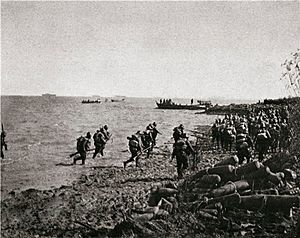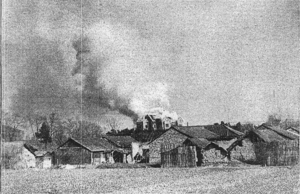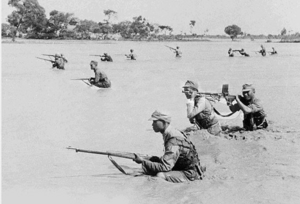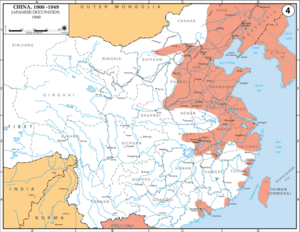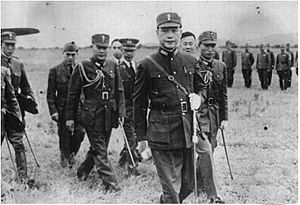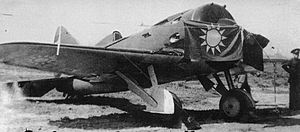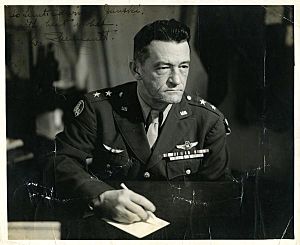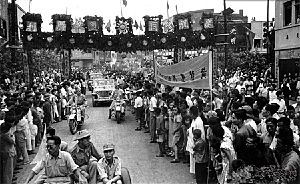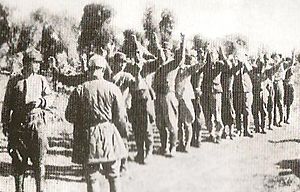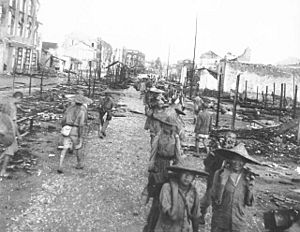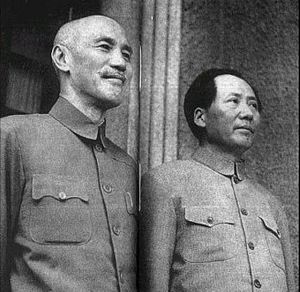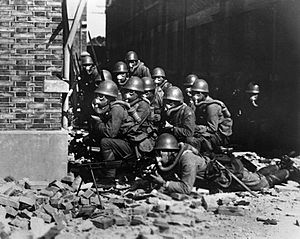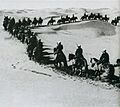Second Sino-Japanese War facts for kids
Quick facts for kids Second Sino-Japanese War |
|||||||||
|---|---|---|---|---|---|---|---|---|---|
| Part of the Pacific theatre of World War II | |||||||||
 Clockwise from top left:
|
|||||||||
|
|||||||||
| Belligerents | |||||||||
|
Foreign support:
(1937–1938) (1937–1941; 1945) (1941–1945) (1942–1945) |
Collaborator support:
(1937–1945) (1937–1945) (1937–1938) (1937–1940) (1938–1940) Government (1940–1945) |
||||||||
| Commanders and leaders | |||||||||
Foreign commanders:
|
Collaborators:
|
||||||||
| Strength | |||||||||
|
|
|
||||||||
| Casualties and losses | |||||||||
|
|
||||||||
| Total casualties: 15,000,000–22,000,000 |
|||||||||
| Second Sino-Japanese War | |||||||
|---|---|---|---|---|---|---|---|
| Chinese name | |||||||
| Traditional Chinese | 抗日戰爭 | ||||||
| Simplified Chinese | 抗日战争 | ||||||
|
|||||||
| Alternative name | |||||||
| Traditional Chinese | 抗戰 | ||||||
| Simplified Chinese | 抗战 | ||||||
|
|||||||
| Alternative name(2) | |||||||
| Traditional Chinese | 八年抗戰 | ||||||
| Simplified Chinese | 八年抗战 | ||||||
|
|||||||
| Alternative name(3) | |||||||
| Traditional Chinese | 十四年抗戰 | ||||||
| Simplified Chinese | 十四年抗战 | ||||||
|
|||||||
| Alternative name(4) | |||||||
| Traditional Chinese | 第二次中日戰爭 | ||||||
| Simplified Chinese | 第二次中日战争 | ||||||
|
|||||||
| Alternative name(5) | |||||||
| Traditional Chinese | (日本)侵華戰爭 | ||||||
| Simplified Chinese | (日本)侵华战争 | ||||||
|
|||||||
| Japanese name | |||||||
| Kanji | 支那事変 日支戦争 日中戦争 |
||||||
| Kana | しなじへん にっしせんそう にっちゅうせんそう |
||||||
|
|||||||
The Second Sino-Japanese War (1937–1945) was a major military conflict. It was mainly fought between the Republic of China and the Empire of Japan. This war was a big part of the Pacific Theater of World War II.
The war officially began on July 7, 1937, with the Marco Polo Bridge Incident. This was a small fight between Japanese and Chinese troops near Beijing that quickly grew into a full invasion. Some historians in China believe the war started earlier, with the Japanese invasion of Manchuria in 1931. China received help from the Soviet Union, the United Kingdom, the United States, and even Nazi Germany at first. Sadly, around 20 million people, mostly regular citizens, died during this war.
Many people see this war as the start of World War II in Asia. It was the largest war in Asia during the 20th century. After Japan attacked Malaya and Pearl Harbor in 1941, the war in China became part of the larger World War II.
Contents
What Led to the War?
Early Conflicts and Japan's Goals
The roots of this war go back to the First Sino-Japanese War (1894–1895). China lost that war and had to give up Taiwan to Japan. Japan also gained control over Korea. At this time, China was weak, while Japan was becoming a strong modern country.
In 1912, the Republic of China was formed. But the country was not truly united. Different warlords controlled different areas. Japan took advantage of this. In 1915, Japan made a list of demands to China to gain more power. After World War I, Japan took over German lands in China. This led to big protests in China.
Japan's Invasion of Manchuria
In 1931, Japan invaded Manchuria after an event called the Mukden Incident. Japan claimed its rights in Manchuria were being ignored. After five months, Japan created a new state called Manchukuo. They put the last Chinese Emperor, Puyi, in charge, but he was just a puppet ruler.
China asked the League of Nations for help. The League said Japan was wrong, but no country took strong action. Japan then left the League of Nations.
Even after this, small fights continued between China and Japan. In 1932, there was a battle in Shanghai. This led to Shanghai becoming a demilitarized zone, meaning China couldn't have troops there. Japan also attacked the Great Wall in 1933. They created a special zone between the Great Wall and Beijing to separate Manchukuo from China.
Japan tried to make Chinese leaders friendly to them. This was called the North China Autonomous Movement. It affected provinces like Hebei and Inner Mongolia. By 1935, the Chinese government had mostly lost control of northern China. Japan supported new governments there.
Some Chinese historians believe the war really started in 1931 with the invasion of Manchuria. This is now the official view in China. They call it the "Fourteen Years' War of Resistance."
The War Begins: 1937 Full-Scale Invasion
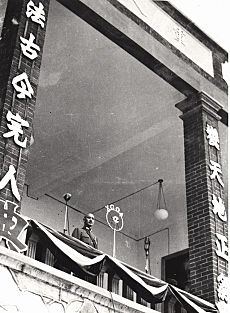
On July 7, 1937, Chinese and Japanese troops clashed near the Marco Polo Bridge, which was important for getting into Beijing. This small fight quickly grew into a big battle. Beijing and its port city, Tianjin, fell to Japanese forces.
Battle for Shanghai
Japan's leaders in Tokyo did not want a full-scale war at first. But China's leader, Chiang Kai-shek, decided it was time to fight back. He sent his best troops to defend Shanghai, China's largest city.
On August 13, 1937, Chinese soldiers attacked Japanese positions in Shanghai. Fierce street fighting began. Chinese planes accidentally bombed a part of Shanghai where many civilians lived, killing over 3,000 people.
The Japanese Navy sent many bombers to destroy the Chinese Air Force. But Chinese fighter planes fought back bravely. The skies over China became a testing ground for new aircraft. The Japanese eventually gained control of the air.
The battle for Shanghai lasted over three months. Japan sent more than 200,000 troops to capture the city. Both sides suffered many losses. On November 9, the Chinese army had to retreat. This battle showed the world that China would not give up easily.
Nanjing Falls and the Massacre
After winning in Shanghai, the Japanese army moved on to Nanjing, which was China's capital city. They captured Nanjing in December 1937. After the city fell, Japanese soldiers committed terrible acts against Chinese citizens. This event is known as the Nanjing Massacre.
The Japanese army looted and burned much of Nanjing. Many estimates say that between 100,000 and 300,000 Chinese people were killed. Japanese textbooks have sometimes downplayed this event, causing anger in China and Korea.
War Continues: 1938-1941
Chinese Resistance and the Yellow River Flood
In 1938, Japan still hoped to control only parts of China. But the Japanese army in China often acted on its own. Chinese forces won a big victory at the Battle of Taierzhuang in March–April 1938.
After this, Japan decided to attack Wuhan, a major Chinese city. They hoped to destroy China's army and force them to make peace.
To stop the Japanese advance, Chiang Kai-shek ordered the dikes on the Yellow River to be broken. This caused massive floods that covered thousands of square kilometers. Thousands of villages were destroyed, and millions of people became refugees. About 400,000 people, including Japanese soldiers, drowned. This act slowed the Japanese but caused huge suffering for Chinese civilians.
Despite this, Japan captured Wuhan in October 1938. The Chinese government moved its capital to Chongqing. Chiang Kai-shek still refused to make peace unless Japan left China.
Japan then started bombing Chinese cities, especially Chongqing. They hoped to break China's will to fight.
Stalemate and Guerrilla Warfare
From 1939, the war entered a new phase. Chinese forces won some battles, like the First Battle of Changsha. China tried a large counter-attack in early 1940, but it failed. China's army was not as well-equipped or trained as Japan's.
Japan controlled most big cities and coastal areas. But they struggled to control the vast countryside. Chinese forces, including the Chinese Communist Party (CCP), used guerrilla warfare to fight the Japanese. They attacked supply lines and caused trouble for the Japanese.
Japan tried to solve its problems by setting up puppet governments in occupied areas. The most famous was the Wang Jingwei Government, led by a former Chinese leader. But these governments were unpopular and had little real power.
By 1941, Japan held much of eastern China. But the Chinese government had moved inland and continued to resist. Chinese guerrillas roamed freely in the countryside.
China's Strategy for Resistance
China's strategy was to drag out the war. They wanted to wear down Japan's resources while building up their own army. This was called "winning by outlasting." Chinese forces would fight to delay the Japanese, allowing people and industries to move to safer areas in the west. They also used "scorched earth" tactics, destroying things so Japan couldn't use them.
Chinese resistance groups, both Nationalist and Communist, kept fighting in occupied areas. In 1940, the Chinese Red Army launched a big attack in northern China, destroying railways. These constant attacks frustrated the Japanese. They responded with a harsh "Three Alls Policy" (kill all, loot all, burn all), which led to many war crimes.
The United States supported China, especially after 1937. But the US continued to sell oil and scrap metal to Japan until 1941. This changed when Japan invaded French Indochina. The US then stopped selling these important resources to Japan.
The Soviet Union also helped China from 1937 to 1941. They sent planes, supplies, and advisors. This help stopped when the Soviet Union signed a neutrality pact with Japan in 1941.
Nationalists and Communists Working Together?
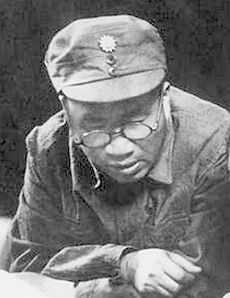
After Japan invaded Manchuria in 1931, many Chinese people wanted to fight Japan. But China's government, led by Chiang Kai-shek and the Kuomintang (KMT), was also fighting a civil war against the Chinese Communist Party (CCP).
In 1936, a Chinese general kidnapped Chiang Kai-shek. He wanted Chiang to stop fighting the Communists and focus on Japan. Chiang agreed to a temporary ceasefire. The KMT and CCP formed a "United Front" against Japan. The Communist armies were placed under the KMT's control.
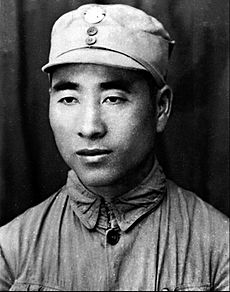
However, this alliance was not strong. Both sides still mistrusted each other. The Communists tried to grow their power behind Japanese lines. Open fighting between Nationalists and Communists became more common after 1940. This led to the New Fourth Army Incident in 1941, where the alliance mostly broke down.
The Communists then focused on building their influence in rural areas. The Nationalists tried to stop the Communists while still fighting Japan.
World War II and China's Role
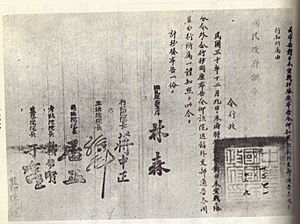
On December 7, 1941, Japan attacked Pearl Harbor in the United States. This brought the US into World War II. Soon after, China officially declared war on Japan, Germany, and Italy. The Sino-Japanese War became part of the larger Pacific War.
Chinese troops won a big victory at the Battle of Changsha in 1942. This earned China respect from its new allies. US President Franklin D. Roosevelt called China one of the "Four Policemen" of the world.
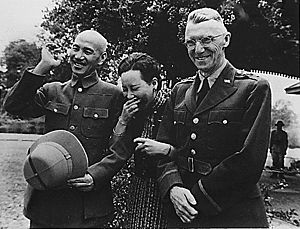
The US sent supplies to China. But sea routes were blocked by Japan. So, supplies had to be flown over the Himalayan Mountains, a dangerous route called "The Hump".
In 1944, Japan launched a huge attack called Operation Ichi-Go. They wanted to capture American airbases in China and connect their railways. This attack brought many Chinese cities under Japanese control.
By late 1944, Chinese troops, with Allied help, pushed the Japanese out of North Burma. They also secured the Ledo Road, a vital supply route from India to China. In 1945, China launched attacks that retook more areas.
Foreign Help for China
Help from Other Countries
Before the full war, Nazi Germany helped China modernize its army. Germany sent military advisors and trained some Chinese divisions. But in 1938, Germany stopped helping China and allied with Japan.
The Soviet Union became China's main supporter from 1937 to 1941. They sent planes, supplies, and advisors. The Soviets wanted to keep Japan busy in China so Japan wouldn't attack Siberia. Soviet help ended in 1941 when they signed a neutrality pact with Japan.
Western Allies' Support
The United States mostly avoided taking sides until 1940. But after the Nanjing Massacre, public opinion in the West turned against Japan. The US, UK, and France started giving loans to China for war supplies.
In 1941, Japan invaded French Indochina. This led the US, UK, and Netherlands to stop selling oil and steel to Japan. This was a big problem for Japan, as they needed these resources for their war in China. This decision helped lead to Japan's attack on Pearl Harbor.
In mid-1941, the US government helped create the American Volunteer Group (AVG), also known as the Flying Tigers. These American pilots flew planes with the Chinese flag and fought Japanese aircraft. They were very successful and became famous.
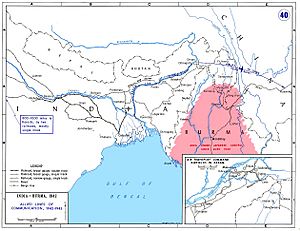
After Japan blocked the Burma Road in 1942, most US and British supplies to China had to be flown over "the Hump" (the Himalayas). This was very dangerous, but the flights continued daily.
The War Ends
Japan's Surrender
The war ended when the United States used a new weapon, the atomic bomb. On August 6, 1945, the first atomic bomb was dropped on Hiroshima. On August 9, a second bomb was dropped on Nagasaki.
Also on August 9, the Soviet Union attacked Japanese forces in Manchuria. The Japanese army there was quickly defeated.
Japanese Emperor Hirohito officially surrendered on August 15, 1945. The formal surrender was signed on September 2, 1945. In China, Japanese troops officially surrendered to Chiang Kai-shek on September 9, 1945.
After the War: Civil War in China
After the war, China was very weak economically. The long war had caused huge damage. There was high inflation and corruption in the Nationalist government. Many cities were destroyed, and millions of people lost their homes.
The Soviet Union took industrial equipment from Manchuria before handing it over to China. This made things harder for China to rebuild.
Meanwhile, the Chinese Communist Party (CCP) grew stronger during the war. They gained popularity by fighting the Japanese and helping poor farmers. Their army became very experienced.
The Chinese Civil War broke out again between the Nationalists and Communists. The Communists, with Soviet help, gained control of Manchuria and then the rest of mainland China. In 1949, the Communists won, establishing the People's Republic of China. The Nationalists retreated to Taiwan.
Impact of the War
China-Japan Relations Today
The Second Sino-Japanese War is still a sensitive topic between China and Japan. China believes Japan has not fully apologized for its actions. Some Japanese textbooks have been criticized for not fully covering Japan's wartime history.
Effects on Taiwan
After the war, Taiwan was given back to China. The Republic of China (ROC) took control in 1945. However, because of the Chinese Civil War, the future of Taiwan became complicated. Japan gave up its claim to Taiwan, but the treaties didn't say who Taiwan belonged to. Today, Taiwan is governed by the ROC.
Taiwan used to celebrate Victory Day and Retrocession Day (when Taiwan returned to China). But some people in Taiwan who want independence have stopped celebrating these days.
War Casualties
The war lasted for over eight years. The total number of deaths was huge, more than half of all deaths in the entire Pacific War.
- Around 20 million Chinese people died, and 15 million were wounded. Most of these were civilians.
- The Nationalist Chinese Army lost over 3.2 million soldiers.
- The Chinese Communist forces lost over 500,000 soldiers.
- Property damage in China was estimated at 383 billion US dollars (in 1937 money).
- The war created 95 million refugees.
- Famines during the war also caused millions of deaths in China.
Japanese records show about 480,000 to 700,000 Japanese soldiers died in China. Many more were wounded or became sick.
Use of Chemical and Biological Weapons
Despite international rules against it, the Japanese army often used chemical weapons like poison gas during the war. They used gas because Chinese forces did not have the same weapons to fight back. For example, gas was used during the Battle of Wuhan to break Chinese resistance.
Japanese forces also used biological weapons. In 1940, they bombed Ningbo with fleas carrying the bubonic plague. These attacks caused outbreaks of disease.
Images for kids
-
Generalissimo Chiang Kai-shek, Allied Commander-in-Chief in the China theatre from 1942 to 1945
-
Propaganda poster depicting American, Chinese and British soldiers; it quotes Herbert Morrison, "This is the only war we have. No matter where it is fighting, Britain is aiming to bring down Japan and its abuse of military power."
-
H. H. Kung and Adolf Hitler in Berlin
-
Generalissimo Chiang Kai-shek, Franklin D. Roosevelt, and Winston Churchill met at the Cairo Conference in 1943 during World War II.
See also
 In Spanish: Segunda guerra sino-japonesa para niños
In Spanish: Segunda guerra sino-japonesa para niños
- Air Warfare of WWII from the Sino-Japanese War perspective
- Aviation Martyrs Cemetery
- Timeline of events leading to World War II in Asia
- List of military engagements of the Second Sino-Japanese War
- List of wars by death toll
General
- History of China
- History of the Republic of China
- Military history of China
- History of Japan
- Military history of Japan



